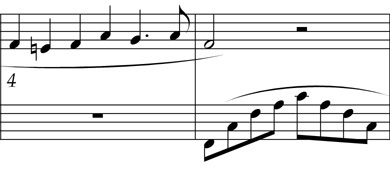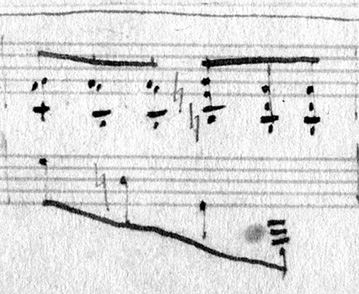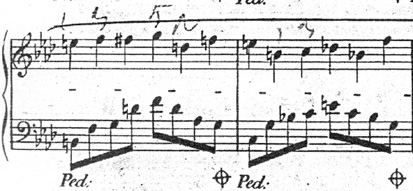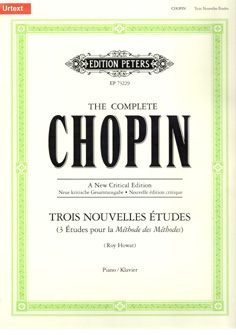EDITION PETERS - EP 73229
THE COMPLETE CHOPIN - A New Critical Edition
TROIS NOUVELLES ÉTUDES (3 Études pour la Méthode des Méthodes)
Urtext - Edited by / Herausgegeben von / Édition de Roy Howat
Leipzig - London - New York / © 2021, pp. IX-12
AFTER years "The Complete Chopin", published by Peters, has been revived by this new edition of the Trois Nouvelles Études composed for the Méthode des Méthodes de Moscheles et Fétis.
Roy Howat, who edited this edition, had already distinguished himself above all as Debussy's editor, where he proved himself—like all the critical music editors we know—not a philologist, but, so to speak, an uncritical music data copyist.
The first thing one notices is both the ugly font used—bulging heavy shape of notehead—and the use of the space: in fact, in order to confine each Etude into two pages, each page contains 6 systems; and the measures with many accidentals are compressed into a cramped space that makes reading rather tiring. We will not go into all the details that would be necessary to examine, but will limit ourselves to a few observations.
In the Preface the editor briefly outlines the structure of the three Etudes: "Etudes 2 and 3—he writes—neatly frame their structures with subtly answering their opening gestures in their closing bars (No. 3 with some ingenuity in bars 65-66)". Here too we find "gestures", a word favoured by fashionable musicologists. We have also consulted Webster, but frankly, what do these f... (the Reader be guessing) "gestures" mean, really escapes us: we admit our ignorance... Less funny are the presumed "some ingenuity". No serious musicologist should allow himself to make a criticism without arguing it, all the more in a critical edition.
The real novelty lies in the following three places.
Étude No. 1, mm. 4÷5 and 20÷21   :
These are two variants taken from dedicatory autographs. In reality, there are also others that the editor does not insert in the main text—an incongruous gesture—but only in the "Critical Commentary". Why? It is not known.
Étude No. 2, m. 24  :
This is not a variant, but a bringing back the original lesson, ignored by all the editors; not even Ekier mentions it! Zimmermann (Henle), indeed, had noticed it, but his comment is as follows: " In A the ♮ before B only from the fourth eighth”, erroneously translated into English: “A postpones the ♮ to the fourth of the eighth", justifying the title of jerk against the musicologist!). According to Howat, who does not specify that the alleged proofs (F0) contain the original lesson, Moscheles would have overcorrected the text while proofreading, but this is highly unlikely. First of all, Moscheles would never have allowed himself such an arbitrariness. Secondly, from Friederike Müller's correspondence (presented elsewhere on this site)—letter dated January 17-18, 1841—, which Howat ignores, we are told that the proofreader in charge was not Moscheles: "Chopin—writes Miss Müller—made me play his 3rd Etude and there were many misprints, all corrected some time ago together with me, but which had been reprinted: which greatly irritated Chopin: C'est Mr Wolff qui aurait dû corrigé cela, mais ce Flegel ne l'a pas fait ; oh, je le connais, il est paresseux comme tout, et Schlesinger ne se donne pas la peine de regarder deux fois. Je vous assure pour ces gens il faut être une brute et leur donner de coups de pieds et des soufflets, alors cela va [It is Mr Wolff who should have corrected them, but this lout did not. Oh, I know him, he's very lazy, and Schlesinger does not bother to check a second time. I can assure you, with these people, you have to be tough and give them a good kicking and a good smacking; then it is all right again].” Therefore, the proofreader in charge was Wolff, not Moscheles; moreover, the fact that in mid-January the reprinted edition (abgedruckt) was full of misprints poses many problems, which we cannot deal with here. However, we can add that if Mikuli had an intense relationship with "Marcelina Czartoryska of Cracow and Friederike Streicher Müller of Vienna", not only epistolary but also in person "in the course of meetings lasting several weeks", reviewing "everything, note by note, with the utmost rigour, collating the numerous corrections and annotations by his [scil. Chopin's] hand with the ones they kept in their notebooks like a relic", Mikuli's edition of these three Etudes should be given due consideration, since from the quoted correspondence it is clear that Friederike Müller studied these pieces with Chopin from their first appearance; and was also a witness to the birth of No. 3.
In the commentary on mm. 9÷17 of Etude No. 1 we read: "1949 edition by Paderewski... shows this RH fingering, attributed to exemplar of Camille Dubois"  and refers the reader to the considerations made on the previous page (but does not mention Bronarski's important observation regarding the edition number, i.e. 2345, which is lower than that of Op. 29, published in 1837 with No. 2467!). That quotation is incomplete, actually, because Bronarski writes (English edition): "The fingering in the bass is repeated from the MS, and in the treble it is given according to the numbers written in pencil, probably by Chopin, in a copy belonging to his pupil, Madame Camille Dubois. In these bars FE does not mark the fingering in print." Why specify that "FE does not mark the fingering”? Which fingering does he refer to? It does not make sense. If it really was a copy belonging to any of Chopin's pupils, how could Schlesinger have included that fingering? In our opinion, a French librarian told Bronarski about the fingering, accompanied by a bizarre hypothesis of his own. Be that as it may, Howat did not notice that this fingering is to be found in the exemplar deposited by Schlesinger on November 16, 1840, held in the Bibliothèque Nationale de Paris and coded "L 6598 (2)": the handwriting is indeed that of Chopin! Since we have only a mediocre photocopy, we report only mm. 16÷17 of this edition, where Chopin's writing is clearer. In the commentary on mm. 2, 5, 6, and 45 of Etude No. 2 Howat says that the “variants” of F2 and F3 “are uncharacteristic enough of Chopin to prompt caution...". Evidently Howat does not have clear ideas; neither did Ekier who inserts those “variants” in the main text! A philologist cannot possibly make personal choices, but, like it or not, must stick to the sources according to the value attributed to them by the recensio. Unspecified "engraving or proofing mishaps" are by no means sufficient to justify those changes to the text, which must be attributed to a specific intention. Fortunately, m. 21 of Etude No. 1 makes it possible to establish that Chopin had nothing to do with F2: in fact the imprudent anonymous proofreader erased the 3 above the A flat, present in F0 and F1. After such an absurd intervention, that corrector could have done anything else stupid, as in fact he did in Etude No. 2. This means that F2 and F3 are sources to be excluded from the recensio.
In m. 39 of Etude no. 3 Howat inserts, by analogy with m. 9, an embellishment that is not written in the autograph. But those measures are not identical: in fact the last but one quaver in m. 9 is a G, while in m. 39 it is an F, which gives the melodic line of the entire measure, which is crescendo, a more “spianato” vocal emission. In any case, to add grace notes by analogy is an unjustifiable arbitrariness. If there is a composer in whom the principle of analogy is hardly ever applicable, he is just Chopin.
In the main text, to m. 42 of Etude No. 3 a variant is attached that is a misreading by the engraver, caused, to tell the truth, by a correction made during copying by Chopin himself who had unintentionally written an A instead of B. Here one can see the difference between a philologist and an uncritical music data copyist.
Finally, speaking of 'performance', Howat argues that “No.1 demands inventiveness of fingering to ensure expressive melodic shaping, while No. 2 invites skilled voicing within the right-hand chords to bring out embedded melodic lines.” Leaving aside the fingerings, let us dwell for a moment on No. 2. In this Etude, the only one of its kind in all piano literature, Chopin rises above the melody, which does not exist, because there is no melody to emerge. The melodies, if you can call it that, are dissolved in a vapour of sound made up of harmonies that blend together like clouds blown by the wind. The great difficulty the interpreter has to face is precisely that of avoiding any melodic allusion and transforming the chords into a subtle sonorous vapour. No one has ever written anything like that and, in all likelihood, no one ever will.
But enough of that. If Roy Howat is entrusted with the edition of all the Etudes, poor Chopin will end up like Debussy...
Six pages of music for about 12 euros.
|
[Dorno, March 22, 2021] |
|
|
|
[All rights reserved © Franco Luigi Viero]
INDIETRO  |
|


 :
: :
: and refers the reader to the considerations made on the previous page (but does not mention Bronarski's important observation regarding the edition number, i.e. 2345, which is lower than that of Op. 29, published in 1837 with No. 2467!). That quotation is incomplete, actually, because Bronarski writes (English edition): "The fingering in the bass is repeated from the MS, and in the treble it is given according to the numbers written in pencil, probably by Chopin, in a copy belonging to his pupil, Madame Camille Dubois. In these bars FE does not mark the fingering in print." Why specify that "FE does not mark the fingering”? Which fingering does he refer to? It does not make sense. If it really was a copy belonging to any of Chopin's pupils, how could Schlesinger have included that fingering? In our opinion, a French librarian told Bronarski about the fingering, accompanied by a bizarre hypothesis of his own. Be that as it may, Howat did not notice that this fingering is to be found in the exemplar deposited by Schlesinger on November 16, 1840, held in the Bibliothèque Nationale de Paris and coded "L 6598 (2)": the handwriting is indeed that of Chopin! Since we have only a mediocre photocopy, we report only mm. 16÷17 of this edition, where Chopin's writing is clearer.
and refers the reader to the considerations made on the previous page (but does not mention Bronarski's important observation regarding the edition number, i.e. 2345, which is lower than that of Op. 29, published in 1837 with No. 2467!). That quotation is incomplete, actually, because Bronarski writes (English edition): "The fingering in the bass is repeated from the MS, and in the treble it is given according to the numbers written in pencil, probably by Chopin, in a copy belonging to his pupil, Madame Camille Dubois. In these bars FE does not mark the fingering in print." Why specify that "FE does not mark the fingering”? Which fingering does he refer to? It does not make sense. If it really was a copy belonging to any of Chopin's pupils, how could Schlesinger have included that fingering? In our opinion, a French librarian told Bronarski about the fingering, accompanied by a bizarre hypothesis of his own. Be that as it may, Howat did not notice that this fingering is to be found in the exemplar deposited by Schlesinger on November 16, 1840, held in the Bibliothèque Nationale de Paris and coded "L 6598 (2)": the handwriting is indeed that of Chopin! Since we have only a mediocre photocopy, we report only mm. 16÷17 of this edition, where Chopin's writing is clearer.